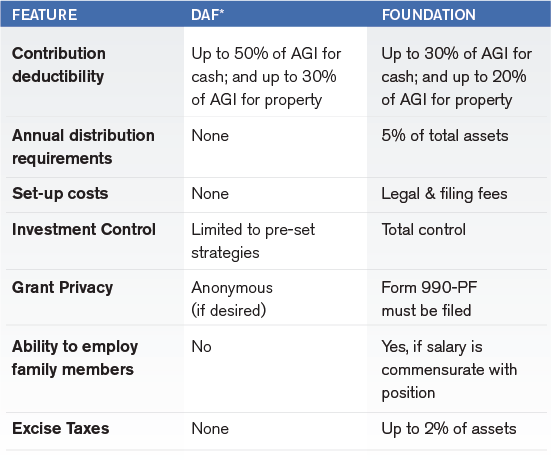Private Client Group Newsletter Q3
By Jennifer Kim, MS, CFP®, CMFC, ChFC, CLU, Senior Partner
Whatever your personal reason for engaging in philanthropy, there are two undeniable facts: Giving can be an incredibly fulfilling experience that when carefully planned and structured, offers meaningful financial benefits.
A planned giving program also affords you more control over what will be given, when it will be given and how it should be used. But which structure is the best fit for your personal circumstances and objectives?
The simplicity of donor- advised funds
Donor-advised funds (DAFs) allow you and your family to make a charitable contribution and receive an immediate tax deduction for the gift; and you can take your time making recommendations for distributing the funds to qualified nonprofit organizations you select (often with the ability to remain anonymous if you so desire).
Assets like appreciated stock that you may not be able to gift directly can be easily gifted through a donor-advised fund since such assets are liquidated and converted to cash when you donate them.
DAFs provide a tax deduction of up to 50 percent of adjusted gross income (AGI) for cash contributions, and 30 percent for appreciated assets. They eliminate the administrative burden by providing you with consolidated recordkeeping and tax reporting. And their simplicity makes them terrific vehicles for introducing philanthropy to your children and involving them in the grant-making process.
More grant-making control with a private foundation
Unlike DAFs, private foundations afford you complete control over grant-making and investment management…But, because they are formal legal entities, foundations must be overseen by directors and trustees (the “board”) responsible for determining how foundation assets will be invested, where and when grants will be distributed and how large those grants should be.
If creating a recognizable legacy for your family name is important to you, the lifespan of a private foundation can continue on for generations. However, the costs to maintain a foundation can be considerable, and the administrative complexity can be daunting. Foundations must also distribute a minimum of 5 percent of assets annually and are required to file separate federal and, in some instances, state income tax returns.
Which is right for you?
The decision between a DAF and a private foundation can be a difficult one, as each strategy comes with its own benefits and drawbacks… Predominantly, the decision comes down to one of control. With a DAF, you choose from a set of pre-existing investment strategies, whereas with a private foundation you’re empowered to make all investment decisions.

If you’re willing to relinquish some control over your gifting and investments, you can gain some key advantages with DAFs, including favorable tax treatment, greatly reduced administrative responsibilities, lower establishment and ongoing costs, no minimum annual distribution requirements and donor anonymity.
Giving can unite your family across years, geographic locations and life circumstances. No matter how old your children are, integrating philanthropy into your family life can be an excellent way to pass on healthy attitudes about money and helping others. Finding the optimal structure for your charitable giving, however, is an important step; and one that your advisor is well equipped to assist you with.
Third Party Site
The information being provided is strictly as a courtesy. When you link to any of the websites provided here, you are leaving this website. We make no representation as to the completeness or accuracy of information provided at these websites. Nor is the company liable for any direct or indirect technical or system issues or any consequences arising out of your access to or your use of third-party technologies, websites, information and programs made available through this website. When you access one of these websites, you are leaving our web site and assume total responsibility and risk for your use of the websites you are linking to.
Dated Material
Dated material presented here is available for historical and archival purposes only and does not represent the current market environment. Dated material should not be used to make investment decisions or be construed directly or indirectly, as an offer to buy or sell any securities mentioned. Past performance cannot guarantee future results.